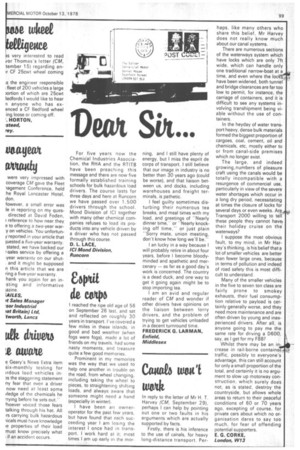Comb milt
Page 101

If you've noticed an error in this article please click here to report it so we can fix it.
In reply to the letter of Mr H. T. Harvey (CM, September 29), perhaps I can help by pointing out one or two faults in his arguments which are actually supported by facts.
Firstly, there is his inference to the use of canals, for heavy long-distance transport. Per
haps, like many others who share this belief, Mr Harvey does not really know much about our canal systems.
There are numerous sections of the waterways system which have locks which are only 7ft ; wide, which can handle only one traditional narrow-boat at a,a time, and even where the locn7
have been widened, both tunnel and bridge clearances are far too low to permit, for instance, the carriage of containers, and it is difficult to see any systems in volving transhipment being viable without the use of containers.
In the heyday of water transport heavy, dense bulk materials formed the biggest proportion of cargoes, coal, cement, oil and chemicals, etc, mostly either to or from canal-side premises which no longer exist.
The large, and indeed growing,numbers of pleasure craft using the canals would be totally incompatible with a resurgence of commercial use,
particularly in view of the severe water shortages which occur in a long dry period, necessitating at times the closure of locks for several days or even weeks. Aresft, Transport 2000 willing to tell these people they cannot have their holiday cruise on the. waterways?
I suppose the most obvious fault, to my mind, in Mr Har vey's thinking, is his belief that a lot of smaller vehicles are better than fewer large ones, because in terms of pollution and indeed of road safety this is most difficult to understand.
Many of the smaller vehicles in the five to seven ton class are fairly prone to smokey exhausts, their fuel consumption relative to payload is cer tainly generally worse, and they need more maintenance and are often driven by young and inex perienced drivers. After all, is anyone going to pay me the same rate for driving a D600, 1, say, as I get for my F88?
Whilst there may be an crease in rail-borne containe;EIKO traffic, possibly to everyone's advantage, this can still account for only a small proportion of the total, and certainly it is no argument to slow up motorway con struction, which surely does not, as is stated, destroy the countryside, but allows whole areas to return to their peaceful conditions of 60 or 70 years ago, excepting of course, for private cars about which no organisation dares to say too much, for fear of offending potential supporters, E. G. CORKE, London, W13
























































































































































































































